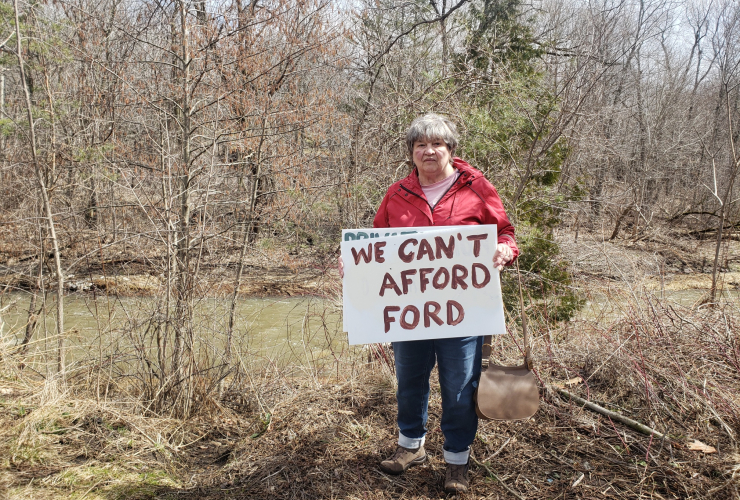Support journalism that lights the way through the climate crisis
Environmental advocates are demanding the federal government halt Ontario's proposed development on former Greenbelt lands after a report found it was warned endangered and threatened species live throughout the region.
A federal briefing note obtained by Global News states 29 at-risk species live or are likely to live on every part of the previously protected lands. The note was prepared in March for Environment and Climate Change Minister Steven Guilbeault.
The species at risk include 13 migratory bird species protected by the Migratory Birds Convention Act, said Hannah Boonstra, spokesperson for Environment and Climate Change Canada.
These species, protected by federal laws, should serve as ammunition for Ottawa to compel Ontario Premier Doug Ford’s government to slow down or even abandon its proposal to construct thousands of homes on the Greenbelt's withdrawn areas, advocates say.
“This report supports the voice of the advocates because our opinions are based on the many decades of studies and reports already done,” said Bonnie Littley, co-founder of the Rouge Duffins Greenspace Coalition and a former Pickering city councillor. “We approached the federal minister of environment for this exact reason and asked that they intervene. We would hope that the government would do exactly that — issue an order to stop everything with a federal environmental assessment.”
Although the federal government has known since March that at-risk species could live in the entire area earmarked for development, so far only one environmental assessment has been ordered, covering only part of the excluded area. In March, Guilbeault ordered an environmental assessment study for the area surrounding Rouge National Urban Park.
The Ontario government has removed 7,400 acres of protected land from the Greenbelt and opened it up to development to address the ongoing housing crisis. It hopes to build 1.5 million new homes across the province in 10 years. The area removed includes the Duffins Rouge Agricultural Preserve (DRAP) area, which shares its western border with Rouge National Urban Park. At nearly 80 square kilometres in size, Rouge is the largest urban park in Canada.
Abdullah Mir, spokesperson for Stop Sprawl Durham, said the immediate focus should be on Rouge Park and the DRAP lands. DRAP in Pickering is the largest contiguous parcel of land taken out of the Greenbelt, comprising 4,700 acres, or over half the land removed. These DRAP lands border Rouge Park, meaning anything that happens there could likely impact Rouge Park.

Secondly, Rouge Park is a national park under the direct jurisdiction of the federal government. Therefore, it may be easier to initiate a study in this area as a starting point, compared to other parcels of land within the Greenbelt, he said.
Yet given the information that species at risk could live in the entire excluded Greenbelt area, Mir said the federal government should demand an environmental impact study for the whole thing.
"It’s all an interconnected system, and it’s us as people who create these largely socio-political divisions of the land. It is important for the federal government to order an environmental impact study at some point for the entire Greenbelt removal area," he said.
The provincial government rationalizes taking land out of the Greenbelt with its commitment to add another 9,400 acres to the Greenbelt elsewhere.
However, Mir points out DRAP is one of the most ecologically sensitive areas in Ontario. A sprawling 4,700 acres east of Toronto, it’s home to more than 1,700 species, including 42 that are considered at risk.
That area will undergo an environmental assessment before any development is approved.
At Guilbeault’s request, the Impact Assessment Agency of Canada (IAAC), Parks Canada and Environment and Climate Change Canada are working together to study the effects of development adjacent to Rouge National Urban Park, said Stéphanie Duchesne, communications manager for IAAC.
“The final report will include public recommendations, notably on whether any legislative or regulatory actions by the Government of Canada would be warranted and, if so, under what circumstances,” Duchesne added. All future proposed development activities will be informed by the assessment, she added.
An independent expert committee will conduct the study, and terms of reference for their work will be done by the end of this month, Duchesne said. Final results should be in by early 2025.
In an email, Mir said environmental assessments slow the development process but don’t necessarily stop it.
“There are cases, however, where the federal government has recommended or issued a freeze on project work when they saw sufficient risk to the habitat of a listed species. For example, in Longueuil QC and La Prairie QC to return protection to the habitat of the western chorus frog. We are hopeful that the ongoing monitoring of flora and fauna within DRAP and other Greenbelt parcels are sufficient to give the Minister of Environment grounds to intervene.”
This story was produced in partnership with Journalists for Human Rights for the Afghan Journalists-in-Residence program funded by the Meta Journalism Project.






Comments